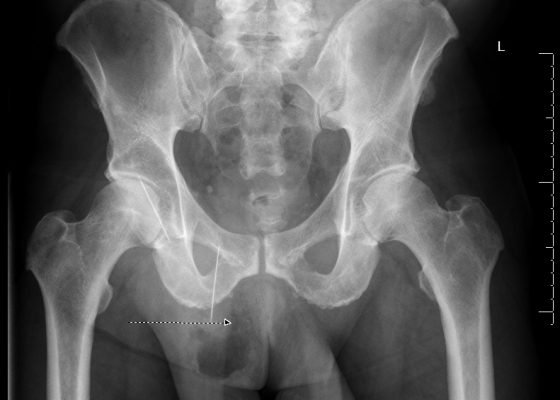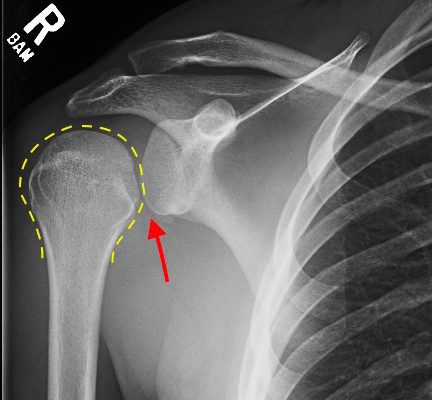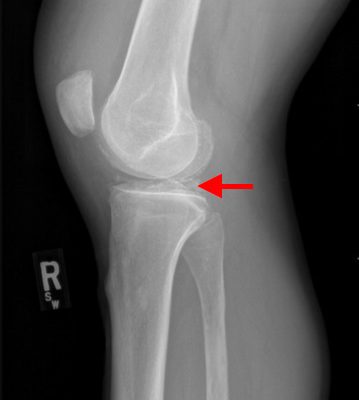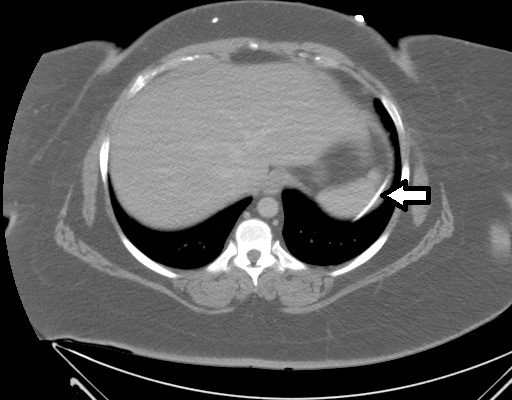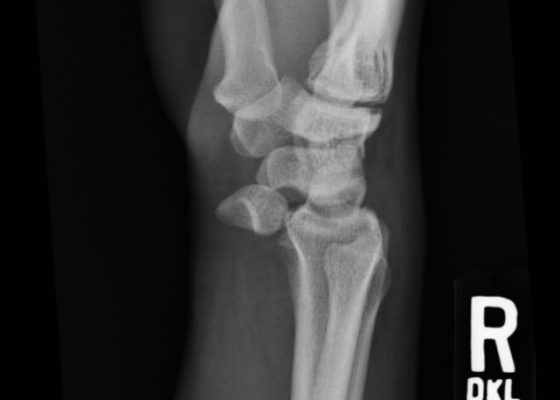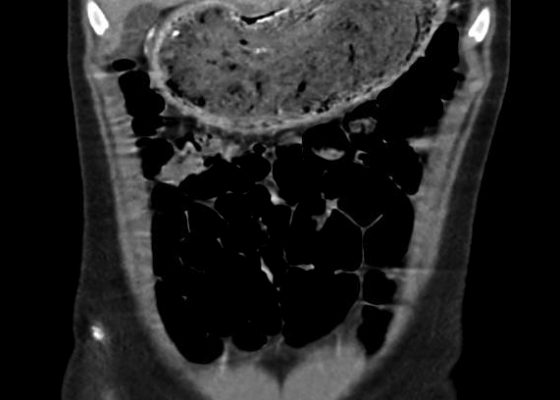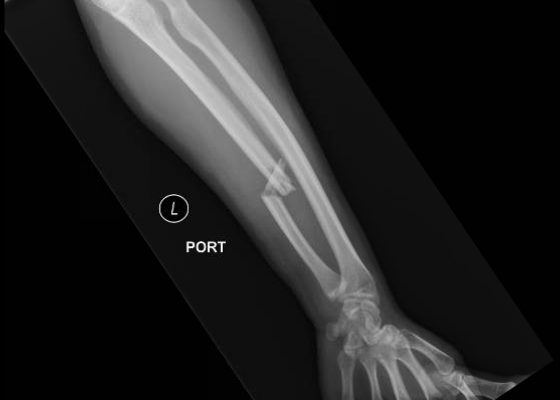X-Ray
Bowel Perforation complicating an incarcerated inguinal hernia
DOI: https://doi.org/10.21980/J8D30BThe AP and lateral pelvis x-rays revealed two sewing needles, 60 mm in length, within the soft tissue over the anterior right lower hemipelvis. In addition, the AP view showed emphysema involving the right hemiscrotum (arrow), concerning for perforated bowel.
An Elderly Female with Dyspnea and Abdominal Pain
DOI: https://doi.org/10.21980/J83S3KRadiography shows a dilated, gas-filled structure that fills nearly the entire left hemi-thorax. Lung markings are visible in the uppermost portion of the left hemi-thorax. There is mediastinal shift to the right. In the visualized portion of the abdomen, dilated loops of bowel are also visualized. This constellation of findings is consistent with a tension gastrothorax.
Irreducible Traumatic Posterior Shoulder Dislocation
DOI: https://doi.org/10.21980/J8V884Radiographs demonstrated posterior displacement of the humeral head on the “Y” view (see white arrow) and widening of the glenohumeral joint space on anterior-posterior view (see red arrow). The findings were consistent with posterior dislocation and a Hill-Sachs type deformity. Sedation was performed and reduction was attempted using external rotation, traction counter-traction. An immediate “pop” was felt during the procedure. Post-procedure radiographs revealed a persistent posterior subluxation with interlocking at posterior glenoid. CT revealed posterior dislocation with acute depressed impaction deformity medial to the biceps groove with the humeral head perched on the posterior glenoid, interlocked at reverse Hill-Sachs deformity (see blue arrow).
Pseudogout and Calcium Pyrophosphate Disease
DOI: https://doi.org/10.21980/J8QG66Radiographs of the knee showed multiple radio-dense lines paralleling the articular surface (see red arrows) consistent with calcium pyrophosphate crystal deposition within the joint often seen in calcium pyrophosphate disease (CPPD) also known as pseudogout.
Ventriculoperitoneal Shunt Migration
DOI: https://doi.org/10.21980/J8G019An immediate post-op abdominal x-ray performed after the patient’s VP shunt revision 30 days prior to this ED visit reveals the VP shunt tip in the mid abdomen. A CT of the abdomen performed on the day of the ED visit reveals the VP shunt tip interposed between the spleen and the diaphragm.
Lunate Dislocation
DOI: https://doi.org/10.21980/J86K56Plain film of the right wrist showed the classic “spilled teacup” consistent with a lunate dislocation. There is a loss of the normal articulation between the distal radius and lunate.
Pediatric Supracondylar Fracture
DOI: https://doi.org/10.21980/J8T88TPlain film radiography showed a displaced supracondylar fracture with disrupted anterior and posterior periostea, consistent with a type 3 supracondylar fracture.
Calcaneal Fractures and Böhler’s Angle
The right ankle lateral radiograph shows a comminuted, non-displaced fracture of the posterior calcaneus (red arrow) in addition to fracture fragments along the heel pad margin (blue arrow). The left ankle lateral radiograph shows a displaced, comminuted fracture of the mid to posterior calcaneus with extension into the subtalar joint posteriorly (purple arrow). There is subcutaneous air seen anteriorly to the tibiotalar joint space (green arrow) in addition to a joint effusion. Of note, the Böhler’s angle in the left x-ray is 16 degrees which is consistent with a fracture (see red annotation showing Böhler’s angle).
Gastric Bezoar
DOI: https://doi.org/10.21980/J85K5WIn the abdominal radiograph, a nonspecific and non-obstructive bowel gas pattern with no air-fluid level was noted, however the stomach was distended with soft tissue. The CT abdomen/pelvis revealed a distended stomach with undigested heterogeneous contents (presumed bezoar).
Monteggia Fracture in an Assault Patient
DOI: https://doi.org/10.21980/J81S3ZOn the axial elbow x-ray, the radial head (red arrow) is dislocated anteriorly from the humerus; the humeroulnar articulation is intact. On the AP forearm x-ray, there is a closed, displaced, comminuted fracture of the ulna (blue arrow).

